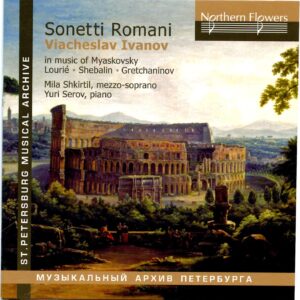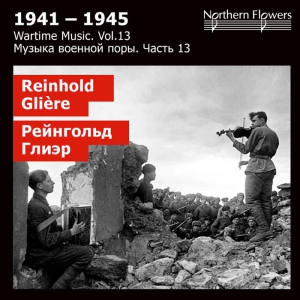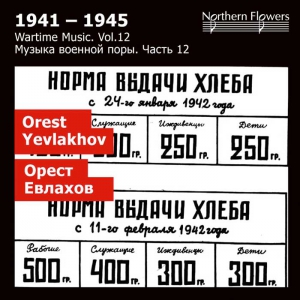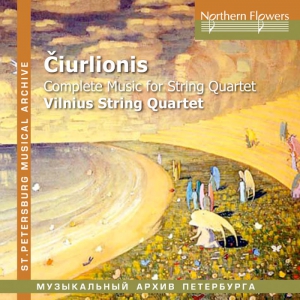Description
Recording location: Notre-Dame du Perpetuel Secours, Paris (France); Recording dates: September 28, 29 & 30, 2005; Sound recording: Jean–Claud Benezech; Artistic supervising: Jean–Paul Imbert; Assistants: Frederic Malaval, Naoko Nomura, Jean Charles Robin; Editing: Alexey Barashkin, St. Petersburg Recording Studio; Design: Nastia Evmenova & Oleg Fakhrutdinov ; Text: Yuri Semionov, Northern Flowers; English text: Sergey Suslov
| José Vianna da Motta (1868–1948) | ||
| Symphony À Pátria (“To the Fatherland”), 1895 | ||
| 1. | Allegro eroico |
9:34 |
| 2. | Adagio molto |
15:16 |
| 3. | Vivace |
6:43 |
| 4. | Andante lugubre. Allegro agitato |
12:54 |
| 5. | Overture Dona Inês de Castro (1886) |
12:43 |
|
Total Time: |
57:17 |
|
|
|
|
|
St. Petersburg Philharmonic Orchestra
Mario Mateus, conductor
Recorded at the St. Catherine Lutheran Church, St. Petersburg, July 26, 27 & 28, 2005
Sound recording and supervision: Alexey Barashkin
Design: Anastassiya Evmenova & Oleg Fakhrutdinov
Providence proved to be extremely benevolent to Alexander Constantinovich Glazunov. He was born in 1865 into the happy family of a well–known Petersburg book publisher, in a large and cozy house, with his parents’ love and care around him. He was endowed with a remarkable musical talent, and a phenomenal memory and ear; abilities glorified in lots of tales and jokes retold by several generations of Petersburg musicians. Thanks to his mother, his gift was noticed very early. The renowned Mily Balakirev and Nikolai Rimsky–Korsakov became his teachers. At the very outset of his creative career, he was greatly encouraged and funded by Mitrofan Belyaev, a timber businessman, passionate music lover, and one of the most important Russian patrons of art.
The First Symphony written by Glazunov at the age of 16 (after 18 months of studies with Rimsky-Korsakov) and performed on March 17, 1882 during a concert of the Free School of Music under Balakirev’s baton, impressed the audience with its clarity, well-finished form, and easy utterance. In his review of the premiere, Cesar Cui commented that the young author “is a composer fully equipped with talent and knowledge”. The composer himself shyly came out to bow in his naīve tunic of a secondary school pupil. The same year, Rimsky–Korsakov conducted the symphony at the Industry & Arts Exhibition in Moscow. Through efforts of M. Belyaev and Franz Liszt, the opus was performed in Weimar in 1884, which started to promote Glazunov’s recognition abroad.
Inborn modesty, reserve, unaffected manners, unusual diligence and responsible attitude to professional composer—s work, honesty, and willingness to help — these personality traits of Glazunov made his name a kind of moral purity standard in the musical world of Petersburg and Russia. The years of his directorship at the Conservatoire of Petersburg (Leningrad) (1905 — 1928), which happened to be years of very dramatic historical cataclysms, are still remembered as one of the most bright and efficient in its history.
In the office of director, Glazunov did not compose much, doing all he could for proper functioning of the Conservatoire. Not only did he know every student by name, but also all of their examination programs, constantly attending the classes and exams. After 1917, he had to deal with matters of heating, food allowances for students and professors, and to ‘extort‘ funds for maintenance of the institution from the government.
The peak of Glazunov’s composing was reached in the late 19th and early 20th century. It was then that he created his ballets of astounding beauty — Raymonda (1897), Les ruses d’amour (1898), and The Seasons (1899), his Fifth (1895), Sixth (1896), Seventh (1902), and Eighth (1906) Symphonies, the famous violin concerto (1904), both piano sonatas, and his best string quartets. In these years, the most fruitful for him, he composes much, but he also constantly conducts, reads lectures at the Conservatoire, and is engaged in public activity.
Glazunov died in 1936 in Paris, where he stayed from 1928 ‘on leave’ off his office as Director of Leningrad Conservatoire by permission of the Soviet Government (being in fact an émigré). He died after a long and painful illness, having left a colossal heritage of compositions comprising eight symphonies, an immense number of orchestral overtures and fantasias, ballets, works for choir and for choir and orchestra, instrumental concertos, seven string quartets, and numerous ensembles and piano pieces.
He always went his own way in music. Being Rimsky–Korsakov’s close friend and follower, Glazunov had as well a sincere liking for his “Moscow opposition”, i.e. Tchaikovsky and Taneyev. His creative work lacks search for new ways in music so typical for the early 20th century, and might seem to be stuck in time. He always remained loyal to the ideals of his musical youth — romantic excitement, exultant air, liveliness.
His compositions seemed obsolete to young contemporaries like Prokofiev and Shostakovich. His composing style looked eclectic, as Glazunov absorbed nearly all of the best things in Russian music of those days that surrounded him. He borrowed commitment to Russian folklore from Balakirev, and he had a lot in common with Rimsky–Korsakov, affinity to colorful and virtuoso orchestration in the first place. The epic beginning of many works of Glazunov reminds the best pages of Borodin’s works. He shared Tchaikovsky’s lyrical attitude, and of course, Taneyev’s commitment to detailed polyphonic development.
Glazunov always tried to achieve a synthesis of what he valued in Russian music. He succeeded in elaborating his own creative style, probably not without certain traits of academism, but possessing a high inner integrity. His compositions are nearly always sanguine and optimistic in their musical images, bright in color, clear in form, and perse in harmony. They are always works of a true master, a composer for whom Beauty was the main criterion of creative achievement.
Northern Flowers
The organ heritage of A.K. Glazunov is not large in itself, comprising two Preludes and Fugues (D-dur, Op. 93, 1906; d-moll, Op. 98, 1914) and Fantasia in G-dur (Op. 110, 1935).
Prelude and Fugue in D-dur is dedicated to Jacque Samuel Handschin (1886–1955), a Swiss music expert and organist who was born in Moscow and spent many years in Russia. Handschin studied organ playing with K. Straube and C.-M. Vidor. In 1909 – 1920 he headed the organ class of St. Petersburg Conservatory, and after 1920 he lived in Switzerland.
Prelude and Fugue in d-moll is dedicated to C. Saint–Saens: “The author dedicates this to great artist Camille Saint-Saëns with utmost reverence”. Glazunov first met Saint–Saëns in Weimar in 1884, during young Glazunov’s visit to Liszt. The friendly connection between the two composers lasted for decades. One of compositions that Saint-Saëns wrote for organ, his Prelude and Fugue Op. 109, No.1 (1898), could serve as an impulse for work on the Prelude and Fugue in d-moll.
Glazunov’s preludes and fugues were published by Belyaev’s publishing house with manual application recommendations made by Handschin to the author’s instructions.
Later Handschin offered a comparative treatise of Glazunov’s organ Opuses 93 and 98 in his article “Russian Music for Organ” published in 1918.
Fantasia in G-dur, Op. 110, the last organ composition by Glazunov, is dedicated to famous French organist Marcel Dupré (1886–1971) who was Glazunov’s consultant during his work on the Fantasia; he also was its premiere performer.
Apart from the original compositions, there are transcriptions of Glazunov’s piano preludes and fugues for organ. In 1909, B.L. Sabaneev, a Moscow musician, transcribed Glazunov’s Prelude and Fugue in d-moll Op. 62 (1899), attaching detailed recommendations for its performance on the Cavaille–Coll organ of Moscow Conservatory.
Yuri Semenov
Vera Zvegintseva
She was born in St. Petersburg (Leningrad), and began her music studies at the age of six. In 1992, she finished the N.A. Rimsky–Korsakov Music School, and in 1998 graduated from St. Petersburg Conservatory in Piano (Y. Pugach) and Organ (Y. Semenov and T. Chausova).
In 2000–2003, Vera Zvegintseva was on probation at la Schola Cantorum in Paris with Jean-Paul Imbert, where she was awarded a diploma as concert organist cum laude. She has attended several organ master classes in England, Scotland, Austria, Italy, Germany, and France.
Vera is active concertising as piano, harpsichord, and organ player in Russia, France, Germany, and Finland. Since 2003, she has been teaching piano and organ at la Schola Cantorum, and since 2003, she has been titular organist at Saint–Charles–Saint–Simon church in Paris. Her repertoire is very ample and comprises music of all epochs and styles, but most of all she is attracted by organ compositions of Russian and today’s composers.





